Md Amirul Islam
Few-Shot-Based Modular Image-to-Video Adapter for Diffusion Models
Dec 23, 2025Abstract:Diffusion models (DMs) have recently achieved impressive photorealism in image and video generation. However, their application to image animation remains limited, even when trained on large-scale datasets. Two primary challenges contribute to this: the high dimensionality of video signals leads to a scarcity of training data, causing DMs to favor memorization over prompt compliance when generating motion; moreover, DMs struggle to generalize to novel motion patterns not present in the training set, and fine-tuning them to learn such patterns, especially using limited training data, is still under-explored. To address these limitations, we propose Modular Image-to-Video Adapter (MIVA), a lightweight sub-network attachable to a pre-trained DM, each designed to capture a single motion pattern and scalable via parallelization. MIVAs can be efficiently trained on approximately ten samples using a single consumer-grade GPU. At inference time, users can specify motion by selecting one or multiple MIVAs, eliminating the need for prompt engineering. Extensive experiments demonstrate that MIVA enables more precise motion control while maintaining, or even surpassing, the generation quality of models trained on significantly larger datasets.
Quantifying and Learning Static vs. Dynamic Information in Deep Spatiotemporal Networks
Nov 03, 2022



Abstract:There is limited understanding of the information captured by deep spatiotemporal models in their intermediate representations. For example, while evidence suggests that action recognition algorithms are heavily influenced by visual appearance in single frames, no quantitative methodology exists for evaluating such static bias in the latent representation compared to bias toward dynamics. We tackle this challenge by proposing an approach for quantifying the static and dynamic biases of any spatiotemporal model, and apply our approach to three tasks, action recognition, automatic video object segmentation (AVOS) and video instance segmentation (VIS). Our key findings are: (i) Most examined models are biased toward static information. (ii) Some datasets that are assumed to be biased toward dynamics are actually biased toward static information. (iii) Individual channels in an architecture can be biased toward static, dynamic or a combination of the two. (iv) Most models converge to their culminating biases in the first half of training. We then explore how these biases affect performance on dynamically biased datasets. For action recognition, we propose StaticDropout, a semantically guided dropout that debiases a model from static information toward dynamics. For AVOS, we design a better combination of fusion and cross connection layers compared with previous architectures.
A Deeper Dive Into What Deep Spatiotemporal Networks Encode: Quantifying Static vs. Dynamic Information
Jun 06, 2022



Abstract:Deep spatiotemporal models are used in a variety of computer vision tasks, such as action recognition and video object segmentation. Currently, there is a limited understanding of what information is captured by these models in their intermediate representations. For example, while it has been observed that action recognition algorithms are heavily influenced by visual appearance in single static frames, there is no quantitative methodology for evaluating such static bias in the latent representation compared to bias toward dynamic information (e.g. motion). We tackle this challenge by proposing a novel approach for quantifying the static and dynamic biases of any spatiotemporal model. To show the efficacy of our approach, we analyse two widely studied tasks, action recognition and video object segmentation. Our key findings are threefold: (i) Most examined spatiotemporal models are biased toward static information; although, certain two-stream architectures with cross-connections show a better balance between the static and dynamic information captured. (ii) Some datasets that are commonly assumed to be biased toward dynamics are actually biased toward static information. (iii) Individual units (channels) in an architecture can be biased toward static, dynamic or a combination of the two.
Simpler Does It: Generating Semantic Labels with Objectness Guidance
Oct 20, 2021



Abstract:Existing weakly or semi-supervised semantic segmentation methods utilize image or box-level supervision to generate pseudo-labels for weakly labeled images. However, due to the lack of strong supervision, the generated pseudo-labels are often noisy near the object boundaries, which severely impacts the network's ability to learn strong representations. To address this problem, we present a novel framework that generates pseudo-labels for training images, which are then used to train a segmentation model. To generate pseudo-labels, we combine information from: (i) a class agnostic objectness network that learns to recognize object-like regions, and (ii) either image-level or bounding box annotations. We show the efficacy of our approach by demonstrating how the objectness network can naturally be leveraged to generate object-like regions for unseen categories. We then propose an end-to-end multi-task learning strategy, that jointly learns to segment semantics and objectness using the generated pseudo-labels. Extensive experiments demonstrate the high quality of our generated pseudo-labels and effectiveness of the proposed framework in a variety of domains. Our approach achieves better or competitive performance compared to existing weakly-supervised and semi-supervised methods.
SegMix: Co-occurrence Driven Mixup for Semantic Segmentation and Adversarial Robustness
Aug 23, 2021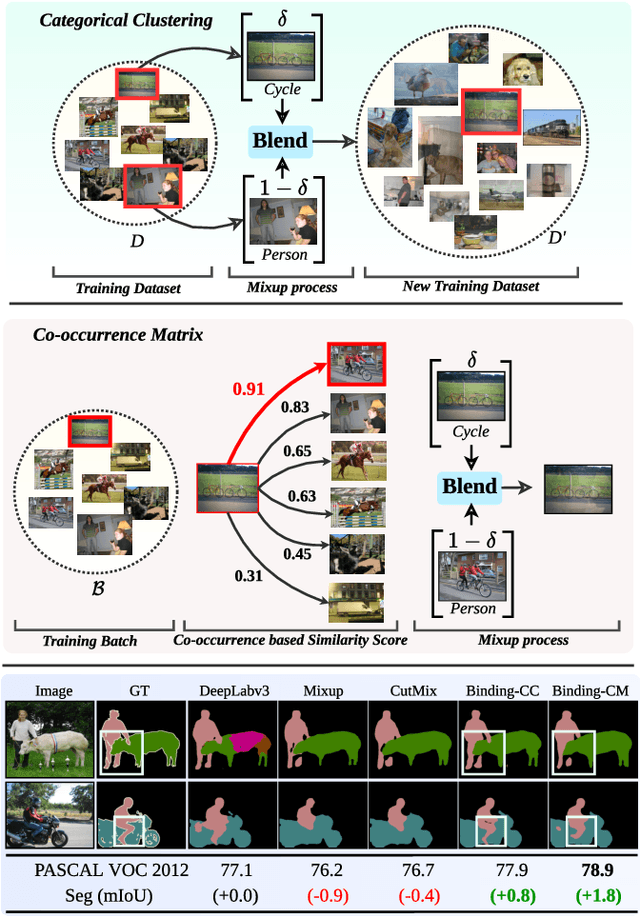
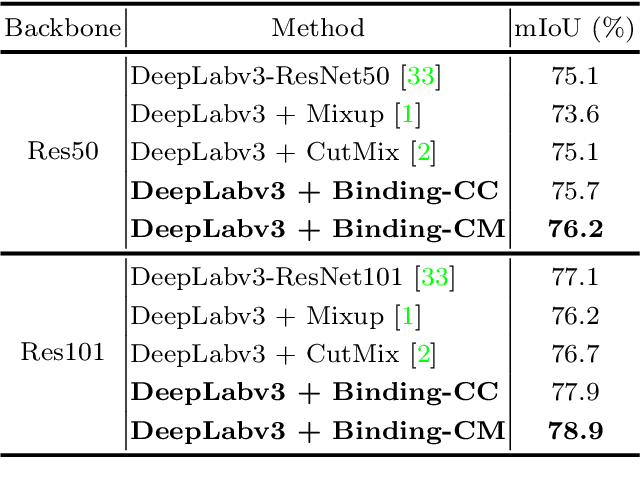

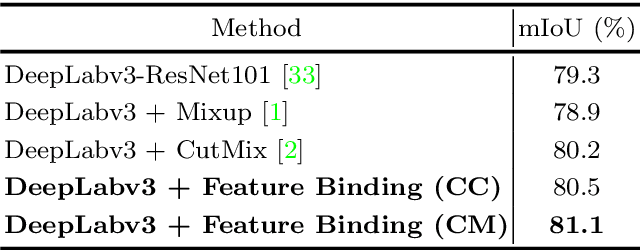
Abstract:In this paper, we present a strategy for training convolutional neural networks to effectively resolve interference arising from competing hypotheses relating to inter-categorical information throughout the network. The premise is based on the notion of feature binding, which is defined as the process by which activations spread across space and layers in the network are successfully integrated to arrive at a correct inference decision. In our work, this is accomplished for the task of dense image labelling by blending images based on (i) categorical clustering or (ii) the co-occurrence likelihood of categories. We then train a feature binding network which simultaneously segments and separates the blended images. Subsequent feature denoising to suppress noisy activations reveals additional desirable properties and high degrees of successful predictions. Through this process, we reveal a general mechanism, distinct from any prior methods, for boosting the performance of the base segmentation and saliency network while simultaneously increasing robustness to adversarial attacks.
Global Pooling, More than Meets the Eye: Position Information is Encoded Channel-Wise in CNNs
Aug 17, 2021
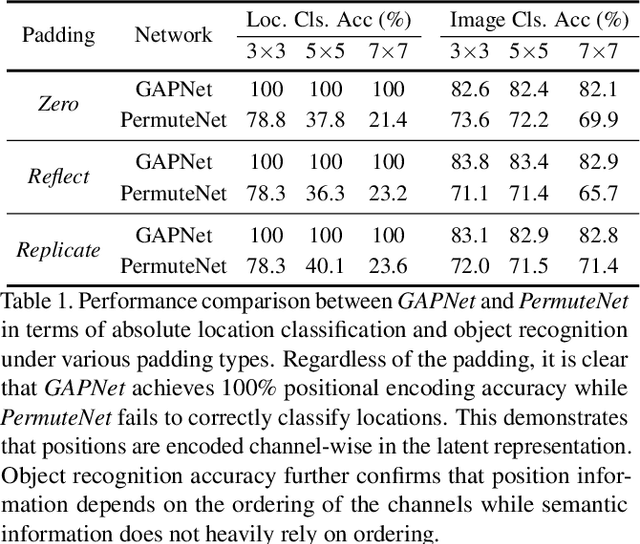


Abstract:In this paper, we challenge the common assumption that collapsing the spatial dimensions of a 3D (spatial-channel) tensor in a convolutional neural network (CNN) into a vector via global pooling removes all spatial information. Specifically, we demonstrate that positional information is encoded based on the ordering of the channel dimensions, while semantic information is largely not. Following this demonstration, we show the real world impact of these findings by applying them to two applications. First, we propose a simple yet effective data augmentation strategy and loss function which improves the translation invariance of a CNN's output. Second, we propose a method to efficiently determine which channels in the latent representation are responsible for (i) encoding overall position information or (ii) region-specific positions. We first show that semantic segmentation has a significant reliance on the overall position channels to make predictions. We then show for the first time that it is possible to perform a `region-specific' attack, and degrade a network's performance in a particular part of the input. We believe our findings and demonstrated applications will benefit research areas concerned with understanding the characteristics of CNNs.
Fibro-CoSANet: Pulmonary Fibrosis Prognosis Prediction using a Convolutional Self Attention Network
Apr 13, 2021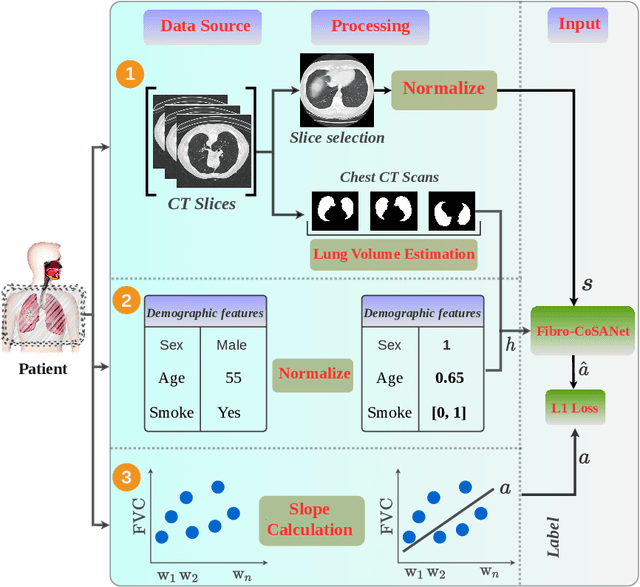


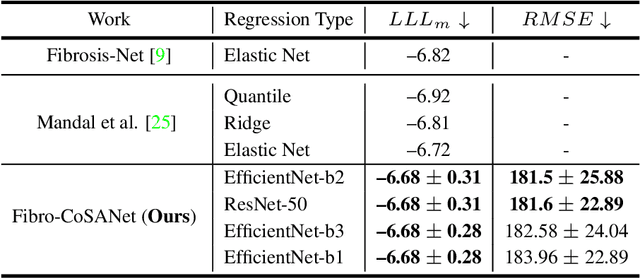
Abstract:Idiopathic pulmonary fibrosis (IPF) is a restrictive interstitial lung disease that causes lung function decline by lung tissue scarring. Although lung function decline is assessed by the forced vital capacity (FVC), determining the accurate progression of IPF remains a challenge. To address this challenge, we proposed Fibro-CoSANet, a novel end-to-end multi-modal learning-based approach, to predict the FVC decline. Fibro-CoSANet utilized CT images and demographic information in convolutional neural network frameworks with a stacked attention layer. Extensive experiments on the OSIC Pulmonary Fibrosis Progression Dataset demonstrated the superiority of our proposed Fibro-CoSANet by achieving the new state-of-the-art modified Laplace Log-Likelihood score of -6.68. This network may benefit research areas concerned with designing networks to improve the prognostic accuracy of IPF. The source-code for Fibro-CoSANet is available at: \url{https://github.com/zabir-nabil/Fibro-CoSANet}.
Position, Padding and Predictions: A Deeper Look at Position Information in CNNs
Jan 28, 2021



Abstract:In contrast to fully connected networks, Convolutional Neural Networks (CNNs) achieve efficiency by learning weights associated with local filters with a finite spatial extent. An implication of this is that a filter may know what it is looking at, but not where it is positioned in the image. In this paper, we first test this hypothesis and reveal that a surprising degree of absolute position information is encoded in commonly used CNNs. We show that zero padding drives CNNs to encode position information in their internal representations, while a lack of padding precludes position encoding. This gives rise to deeper questions about the role of position information in CNNs: (i) What boundary heuristics enable optimal position encoding for downstream tasks?; (ii) Does position encoding affect the learning of semantic representations?; (iii) Does position encoding always improve performance? To provide answers, we perform the largest case study to date on the role that padding and border heuristics play in CNNs. We design novel tasks which allow us to quantify boundary effects as a function of the distance to the border. Numerous semantic objectives reveal the effect of the border on semantic representations. Finally, we demonstrate the implications of these findings on multiple real-world tasks to show that position information can both help or hurt performance.
Shape or Texture: Understanding Discriminative Features in CNNs
Jan 27, 2021

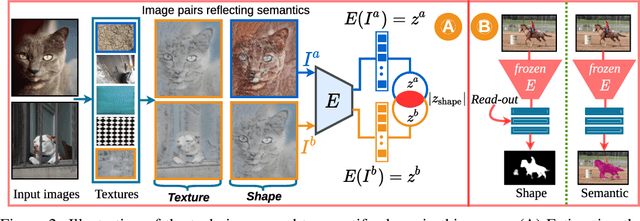
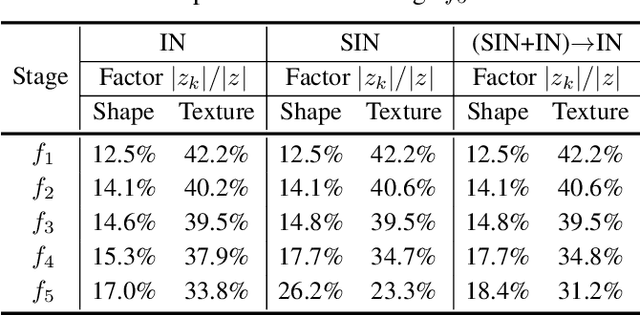
Abstract:Contrasting the previous evidence that neurons in the later layers of a Convolutional Neural Network (CNN) respond to complex object shapes, recent studies have shown that CNNs actually exhibit a `texture bias': given an image with both texture and shape cues (e.g., a stylized image), a CNN is biased towards predicting the category corresponding to the texture. However, these previous studies conduct experiments on the final classification output of the network, and fail to robustly evaluate the bias contained (i) in the latent representations, and (ii) on a per-pixel level. In this paper, we design a series of experiments that overcome these issues. We do this with the goal of better understanding what type of shape information contained in the network is discriminative, where shape information is encoded, as well as when the network learns about object shape during training. We show that a network learns the majority of overall shape information at the first few epochs of training and that this information is largely encoded in the last few layers of a CNN. Finally, we show that the encoding of shape does not imply the encoding of localized per-pixel semantic information. The experimental results and findings provide a more accurate understanding of the behaviour of current CNNs, thus helping to inform future design choices.
Bidirectional Attention Network for Monocular Depth Estimation
Sep 01, 2020
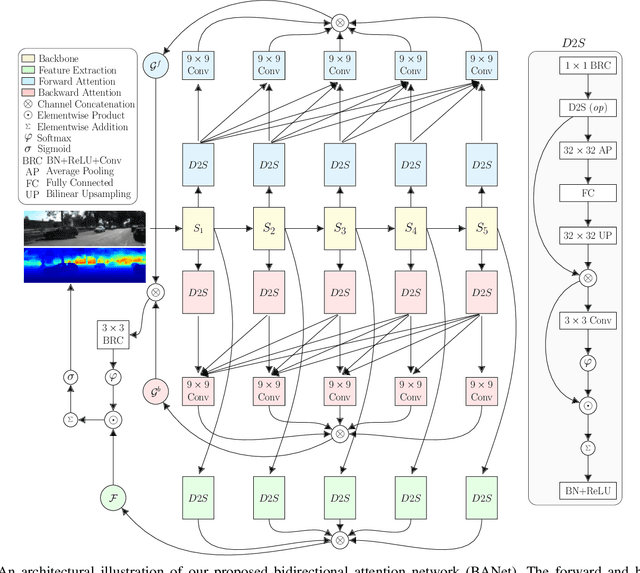

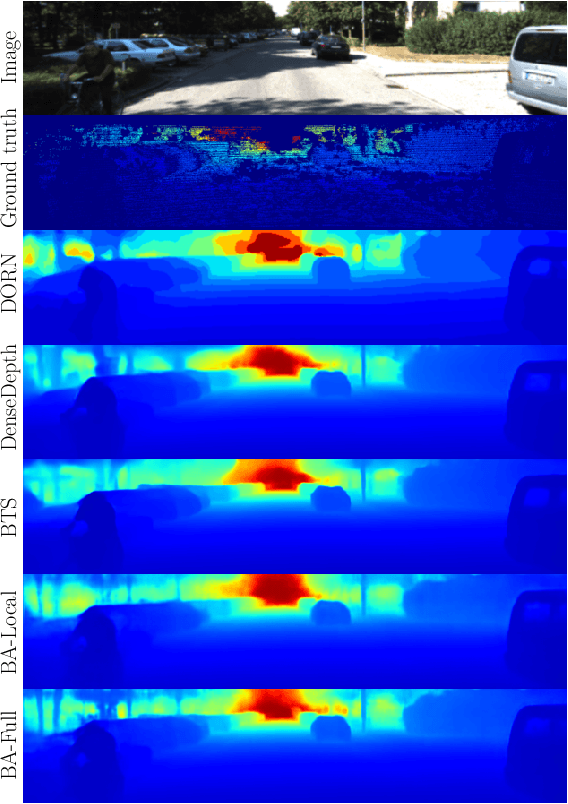
Abstract:In this paper, we propose a Bidirectional Attention Network (BANet), an end-to-end framework for monocular depth estimation that addresses the limitation of effectively integrating local and global information in convolutional neural networks. The structure of this mechanism derives from a strong conceptual foundation of neural machine translation, and presents a light-weight mechanism for adaptive control of computation similar to the dynamic nature of recurrent neural networks. We introduce bidirectional attention modules that utilize the feed-forward feature maps and incorporate the global context to filter out ambiguity. Extensive experiments reveal the high degree of capability that this bidirectional attention model presents over feed-forward baselines and other state-of-the-art methods for monocular depth estimation on two challenging datasets, KITTI and DIODE. We show that our proposed approach either outperforms or performs at least on a par with the state-of-the-art monocular depth estimation methods with less memory and computational complexity.
 Add to Chrome
Add to Chrome Add to Firefox
Add to Firefox Add to Edge
Add to Edge